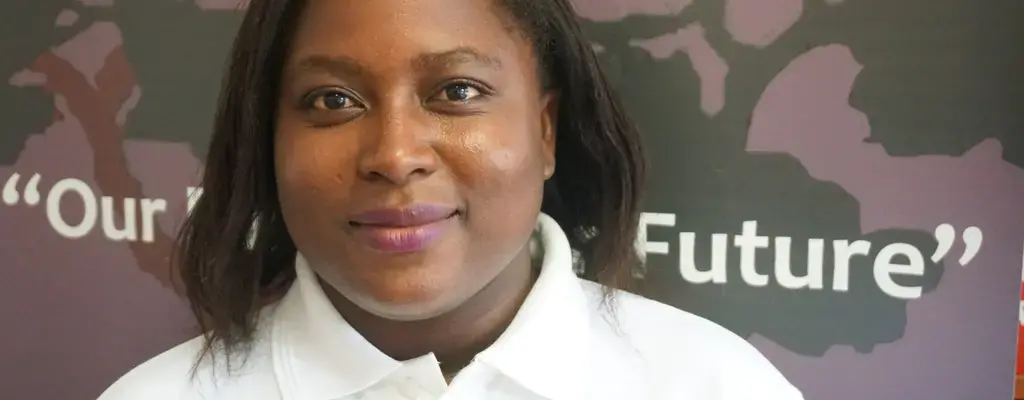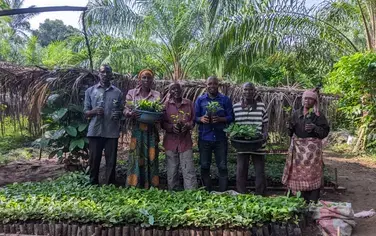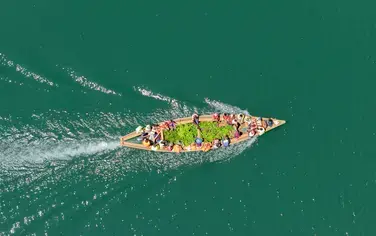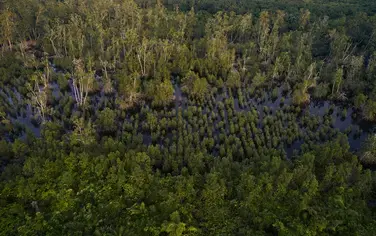Alinafe Kaudzu is Local Technical Coordinator for the Conservation and Sustainable Management of the Dzalanyama Forest Reserve (COSMA DFR) project, which is being supported by Japan International Cooperation Agency. The Lilongwe Water Board, in partnership with the Malawi's Department of Forestry, is restoring critical water catchments in the reserve, which provides a lifeline for Lilongwe because it supplies clean and potable water to millions of people. This is in line with the African Forest Landscape Restoration Initiative (AFR100), which aims to bring 100 million hectares of land across Afica into restoration by 2030. I caught her during this year's tree planting at Katete Plantations on the outskirts of Lilongwe city.
In 2014 an emergency appeal was made by authorities urging the private sector, government departments and local communities to rescue Dzalanyama Forest Reserve, considering its role in protecting biodiversity and Lilongwe's water supply. Tell our readers the extent of the damage and the steps towards restoring this important resource.
The forest faced massive destruction mainly through charcoal production, large-scale firewood collection, brick production, tobacco curing and uncontrolled forest fires. Between 2013 and 2015, the reserve lost 15% of its biomass. In response, the Office of the President and Cabinet held the first stakeholders’ meeting in January 2015. They decided to engage the Malawi Defence Force's patrol operations and about 40 soldiers were deployed with funding from Lilongwe Water Board. Concurrently, an Emergency Action Plan (EAP) was drafted to strategize short- to medium-term interventions. To solve the serious technical and financial constraints, the Government of Malawi requested technical cooperation from the Government of Japan, leading to the creation of the COSMA-DFR. The project includes forest restoration and management activities, including trialling sustainable charcoal production as supported by the National Charcoal Strategy, livelihood improvement, a financial mechanism for sustainability after COSMA-DFR phases out, communication and environmental education, and monitoring and evaluation.
Surely, dealing with a scale of the problem in Dzalanyama need a multi-sectoral approach, as issues of energy poverty and population growth are among the driving factors. Who else are you working with?
Realizing that forest conservation requires a holistic approach, we have a broad engagement of stakeholders. Our main counterpart institutions are the Department of Forestry and Lilongwe Water Board and the surrounding communities, but we also work with non-governmental organizations like Wildlife Environmental Society and cooperatives like Maluso Cooperative Union. We work with various government departments through working groups and in tree planting exercises. There are also private sector institutions like Alliance One International Tobacco Company and the Limbe Leaf Tobacco Company. A beverage company called ZAMM Investment produces Cool Drop, a bottled water that supports conservation activities through eco-labelling. Since January 2018, COSMA-DFR has received monthly remittances from their sales. In the banking sector, we work with National Bank of Malawi.
How are instruments like the National Charcoal Strategy and National Forest Landscape Restoration Stratregy helping in this fight?
The National Charcoal Strategy looks at the following pillars, which also help the project to accomplish its goals: promoting alternative household cooking fuels; promoting adoption of fuel-efficient cookstove technologies; promoting sustainable wood production; regulation of sustainable charcoal production; enhancing livelihoods; promoting information, awareness and behavior-change communications; and strengthening law enforcement. On the other hand, the National Forest Landscape Restoration Strategy, which is part of Malawi's commitment to AFR100, identifies priority opportunities and interventions that lead to improved food security, increased biodiversity, improved water supply, job creation, income, carbon sequestration and enhanced resilience to climate change. The ultimate goal is to create enabling conditions, at scale, that incentivize and reward the sustainable use of natural resources. COSMA-DFR aims to achieve the same goals.
You have participated in tree planting in the Reserve for 5 times now. Are you monitoring these trees to check their survival rate? How is natural regeneration progressing?
On average, the survival rate is 70%. Natural regeneration is improving every year thanks to the MDF, especially in areas with less charcoal production records like Dedza, where we have the Community Forestry Scouts, made up of members of the local communities, patrolling.
How are you working with the local communities to ensure they play their role in managing the reserve as custodians living on the reserve peripheral.
We understand that if communities are not involved in conservation activities, they might be part of the problem. We are engaging them in various activities. These include the community patrols amd seedling production for profit-making and planting in Dedza and in the traditional authority area of Masumbankhunda in Lilongwe, respectively. Villagers are also employed as casual laborers in tree planting and forest management activities, especially in areas close to the two plantations within the Reserve. There is also a component of bee keeping, which is part of the livelihood improvement campaign that engages the communities. We also developed a documentary that we use to inform the communities about why we are conserving the Reserve, the dangers of not conserving the reserve, the policies that govern forest conservation, amd interventions in practice, and about the benefits they can sustainably gain from the reserve like collection of seasonal non-wood forest products.
What other information do you want to share with our readers at national level?
The forests provide a wide range of ecosystem services to the surrounding communities and the nation at large, so sustainable management can guarantee benefits to us all. Poverty is no excuse to destroy natural resources that take decades to reach maturity, so we should embrace other income generating activities. Having a disturbed environment is disturbing our livelihoods, and everyone feels the consequences. Let us embrace new ways of cooking and producing energy, avoiding bush fires, halting deforestation, and planting and managing forests to secure water, food and environment.




